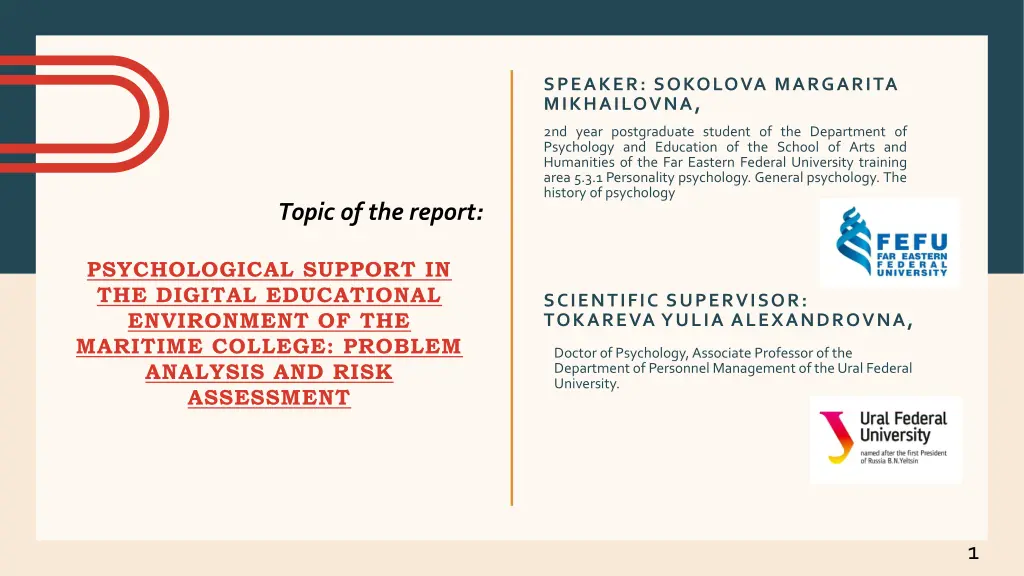
Psychological Support in the Digital Educational Environment: Risk Assessment in Maritime College
Explore the influence of the digital environment on adolescents' development and internet addiction. This study analyzes psychological support in a maritime college through empirical research methods, surveys, and essays to address potential risks in the digital educational landscape.
Download Presentation

Please find below an Image/Link to download the presentation.
The content on the website is provided AS IS for your information and personal use only. It may not be sold, licensed, or shared on other websites without obtaining consent from the author. If you encounter any issues during the download, it is possible that the publisher has removed the file from their server.
You are allowed to download the files provided on this website for personal or commercial use, subject to the condition that they are used lawfully. All files are the property of their respective owners.
The content on the website is provided AS IS for your information and personal use only. It may not be sold, licensed, or shared on other websites without obtaining consent from the author.
E N D
Presentation Transcript
SPEAKER: SOKOLOVA MARGARITA MIKHAILOVNA, 2nd year postgraduate student of the Department of Psychology and Education of the School of Arts and Humanities of the Far Eastern Federal University training area 5.3.1 Personality psychology. General psychology. The history of psychology Topic of the report: PSYCHOLOGICAL SUPPORT IN THE DIGITAL EDUCATIONAL ENVIRONMENT OF THE MARITIME COLLEGE: PROBLEM ANALYSIS AND RISK ASSESSMENT SCIENTIFIC SUPERVISOR: TOKAREVA YULIA ALEXANDROVNA, Doctor of Psychology, Associate Professor of the Department of Personnel Management of the Ural Federal University. 1
PEOPLE TIME RISK Versatility makes social networks a convenient tool for various social interactions, including for educational purposes, and in adolescence -an important channel for mastering social practices, a tool for socialization. One of the main directions of the development of modern school and secondary vocational education is the digitalization of education, which involves ensuring the security of the digital educational environment. The report is devoted to the issue of the influence of the digital environment on the development of the personality of adolescents and the importance of supporting this aspect from the psychological service of an educational institution. RELEVANCE 2
To identify the degree of influence of the digital environment on the development of Internet addiction among cadets of the Marine Engineering College of the Maritime Academy at the G.I. Nevelsky Maritime State University. THE PURPOSE OF THE STUDY: 3
THE PROCEDURE FOR CONDUCTING AN EMPIRICAL STUDY STAGE 4 Research methods and sampling: 120 students aged 15-17 years took part in the study: 78 boys and 42girls. Processing the results. Feedback STAGE 3 Writing essays by cadets. The cadets were asked to write an essay on the topic "I am an ideal professional of the maritime profession" STAGE 2 Conducting a personal conversation with each cadet on the topic of addiction as a form of additive behavior. STAGE 1 The diagnosis of the cadets was divided into 2 stages: 1)20.10.2023-10.12.2023 cadets of 1-2 courses (60 people) 2) 20.01.2024-20.02.2024 cadets of 1-2 courses (60 people) 4
RESEARCH METHODS THE TEST "DETERMINING THE GENERAL EMOTIONAL ORIENTATION OF PERSONALITY" (B.I. DODONOV), TH E P E R S O NA L Q U E S TI O NNA I R E O F G . E Y S E NC K, TH E M O D I F I C A TI O N O F T. V . M A TO L I N (A D O L E S C E NT V E R S I O N), THE SCALE OF NEUROTICISM & THE SCALE OF PSYCHOTICISM THE KIMBERLY YOUNG TEST FOR INTERNET ADDICTION The studywasconductedusingthefollowingmethods: 1) The KimberlyYoungtestfor Internetaddiction, 2) the Personal questionnaire of G. Eysenck, the modificationofT.V.Matolin(adolescent version), 4) Thescale Extraversion-introversion , 5) theScaleof neuroticism, 6) theScale ofpsychoticism, 7)the test "Determining orientation of personality" (B.I.Dodonov), 8) the test for diagnosing the tendency to deviant behavior (SOP)A.N.Orel, 9) Schubert'smethod "Riskreadiness", 10) M. Zuckerman's method propensitytoextreme risky behavior". M . M E T H O D A S S E S S M E N T P R O P E N S I T Y E X T R E M E B E H A V I O R " Z U C K E R M A N ' S THE SCALE OF EXTRAVERSION - INTROVERSION " S E L F - O F T O R I S K Y the general emotional "Self-assessment of THE TEST FOR DIAGNOSING THE TENDENCY TO DEVIANT BEHAVIOR (SOP) A.N. OREL 5
32 cadets with improved results using the specified methods were identified. The main directions for further work on the prevention of addictive behavior by a teacher-psychologist developed in the direction of reduction. in cadets have been MAIN RESULTS: 6
PEOPLE TIME RISK Purposeful correctional work of a teacher-psychologist in college with teenage cadets who have signs of Internet addictive behavior makes it possible to reduce the severity of signs of addiction and improve the behavioral manifestations of adolescents. CONCLUSION 7
THANK YOU FOR YOUR ATTENTION! 8

